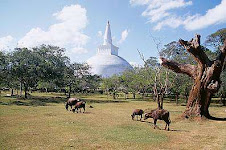Five centuries before Christ,
Cities, palaces, reservoirs and parks, temples, mon
asteries, monuments and works of art bore testament to the character, imagination, culture, philosophy and faith of the Sri Lankan peopl
e, the
be researched from
oconut palms and alongside deep jungle in which elephant and leopard
roam.
Recorded history emerges from the mists sometime after the advent of Sinhala, apparently before the 5th century B.C. These were it is believe
d, a North Indian people of Aryan ancestry, who settled first in the north-central plains and raised in the Island an agricultural elite whose feats of irrigation excite wonder to this day and founded a system of government th
at proved viable for more than two thousand years.
By the middle of 3rd century BC, the fame of the capital,
em. Three centuries after that as far-flung a connec
tion had been established eastwards, with
In 247 BC occurred the greatest single event in Sri Lankan hist
ory, when through the missionary labors of the monk Mahi
nda, son of Buddhist Emperor Asoka of India, the
Island’s king, court and commoners were converted to Buddhism. In
of holy relic, orthodox doctrine and a goal
of pilgrimage.
About the same period began the Dravidian invasions w
hich for a thousand five hundred years were to fall upon the
Under the Dravidian pressure, however, the capital, after having survived in Anuradhapura up to the 10th century, had to be withdrawn again and again: to Polonnaruwa, to the rocky forest around Kurunegala, to Kotte near Colombo, finally to the Kandyan hills whrere the Sinhala Kingdom made its last stand.

128 miles from  vansa, the Sinhala Buddhist chronicle, the city was a mod
vansa, the Sinhala Buddhist chronicle, the city was a mod
el of planning. Precincts were set aside for huntsmen and scavengers and even heretics
and foreigners . There were hostels and hospitals, separate cemeteries for high and low castes. A water supply was assured by the construction of reservoirs.
ndred years as the national capital. But internecine struggles the royal succession grew, and it became more and more vulnerable to the pressures of South Indian political expansions. The city was finally abandoned and the capita
l withdrawn to more secluded areas.
But the
MIHINTALE

Over 7 miles of
ade of granite slabs 15” wide, leads to the summit, from where one could get a splendid view of the surrounding countryside.
POLONNARUWA

135 miles (216km) from
The city it self, as well as the surrounding plain was watered by unique irrigation complex known as the Sea of Parakrama (Parakrama Samudra) so vast was its scale.
SIGIRIYA

Sigiriya was no mere fortress, gloomy and forbidding. At the brief height of its glory- it was a royal citadel for more than 18 years, from 477 to 495 AD and one of the loveliest that have graced this land.
There are many interpretations of the Sigiriya period, history replete with legend, love and betrayal. But one story remains, the story of Kasyapa (477-495 AD) itc creator, King with an artist’s soul. Bards have written about him and plays and films tried to capture his personality.
Kasyapa left
In a sheltered pocket on the western face of the Sigiriya rock, approached by a spiral stairway, are the famous frescoes. Epigraphical evidence refers to the existence of 500 such portraits, but only 19 remain today.
On the western and northern sides of the steep rock face runs a gallery of pathway which provides access to pathway is a 9 ½ ft plaster wall, so highly polished that even today. After 15 centuries of exposure to sun, wind and rain, one can see one’s reflection in it. So it called “the mirror wall”.
There are Graffiti writings on that polished wall written by visitors to the rock in the past. The rock is about nearly three acres. There are ruins of gardens, ponds, paleces on the top of the rock. And the underground drain system is amazing.
DAMBULLA
Dambulla is about 12 miles away from Sigiriya. It is an isolated rock about 500ft tall. There is famous Rangiri Dambullu Viharaya. A rock-temple built in 1st century BC. There are five main cave shrines. Any one can see the beautiful landscape from the top of the rock. It’s hypnotizing.
YAPAHUWA

Yapahuwa is an ancient fortress. It was the capital city in 1301 AD as well. It built on a rock about 300ft high. It is also an unbelievable creation of ancient Sri Lankan architects.
webXtremses













